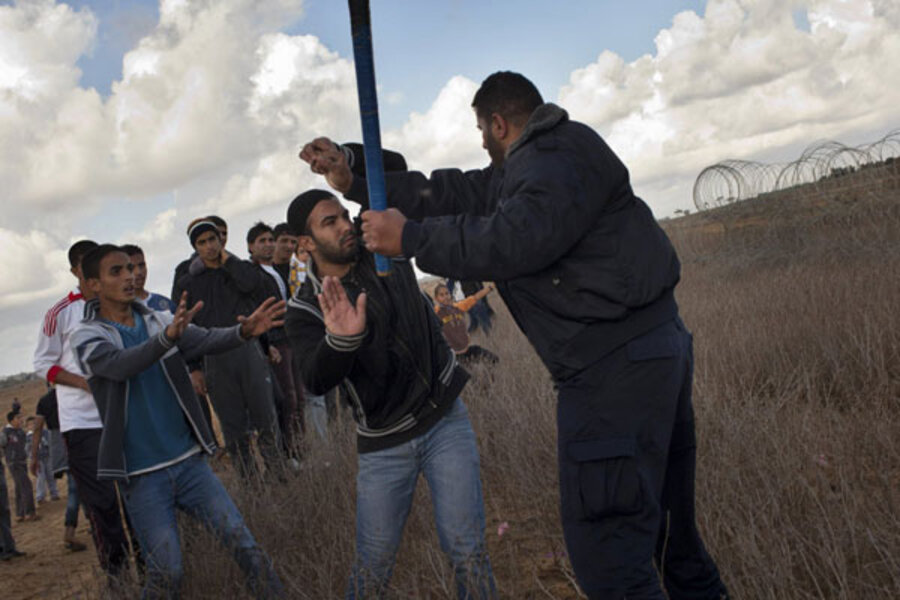Gaza truce holding even after Palestinian death
Loading...
Israeli troops fired Friday to push back Gaza crowds surging toward Israel's border fence with the Hamas-ruled territory, killing one Palestinian and wounding 19 in the first violence since a truce between Israel and Hamas took hold a day earlier.
Hamas security tried to defuse the situation and keep the crowds away from the border, signaling the incident is unlikely to jeopardize the Egyptian-brokered cease-fire.
The truce, which calls for an end to Gaza rocket fire on Israel and Israeli airstrikes on Gaza, came after eight days of cross-border fighting, the bloodiest between Israel and Hamas in four years.
On Friday, hundreds of Palestinians approached Israel's border fence in several locations in southern Gaza.
In the past, Israel's military barred Palestinians from getting close to the fence, and soldiers routinely opened fire on violators to enforce a 300-meter-wide no-go zone meant to prevent infiltrations into Israel.
Since the cease-fire, growing numbers of Gazans have entered the no-go zone, testing expectations that such restrictions would now be lifted.
In one incident captured by Associated Press video, several dozen Palestinians, most of them young men, approached the fence, coming close to a group of Israeli soldiers standing on the other side.
Some Palestinians briefly talked to the soldiers, while others appeared to be taunting them with chants of "God is Great" and "Morsi, Morsi," in praise of Egyptian President Mohammed Morsi, whose mediation led to the truce.
At one point, a soldier shouted in Hebrew, "Go there, before I shoot you," and pointed away from the fence, toward Gaza. The soldier then dropped to one knee, assuming a firing position. Eventually, a burst of automatic fire was heard, but it was not clear whether any of the casualties were from this incident.
Most of those approaching the fence were young men, but the crowds also included farmers hoping they could once again farm lands in the buffer zone. Speaking by phone from the buffer zone, 19-year-old Ali Abu Taimah said he and his father were checking three acres of family land that have been fallow for several years.
"When we go to our land, we are telling the occupation (Israel) that we are not afraid at all," he said.
Gaza health official Ashraf al-Kidra said a 20-year-old man was killed and 19 people were wounded by Israeli fire near the border.
Israel's military said roughly 300 Palestinians approached the security fence at several locations in southernGaza, tried to damage it and cross into Israel. Soldiers fired warning shots in the air to distance the Palestinians from the fence, but after they refused to move back, troops fired at their legs, the military said. It also said a Palestinian infiltrated into Israel in the course of the unrest, but he was returned to Gaza.
The truce allowed both Hamas and Israeli Prime Minister Benjamin Netanyahu to step back from the brink of a full-fledged war. Over eight days, Israel's aircraft carried out some 1,500 strikes on Hamas-linked targets, whileGaza fighters peppered Israel with roughly the same number of rockets.
The fighting killed 166 Palestinians, including dozens of civilians, and six Israelis.
In Cairo, Egypt is hosting separate talks with Israeli and Hamas envoys on the next phase of the cease-fire — a new border deal for blockaded Gaza. Hamas demands lifting of all border restrictions, while Israel insists that Hamas must halt weapons smuggling to the territory.
In Israel, a poll showed that about half of Israelis think their government should have continued its military offensive against Hamas.
The independent Maagar Mohot poll released Friday shows 49 percent of respondents feel Israel should have kept going after squads that fire rockets into Israel. Thirty-one percent supported the government's decision to stop. Twenty percent had no opinion.
Twenty-nine percent thought Israel should have sent ground troops to invade Gaza. The poll of 503 respondents had an error margin of 4.5 percentage points.
The same survey showed Netanyahu's Likud Party and electoral partner Israel Beiteinu losing some support, but his hard-line bloc would still able to form the next government. Elections are Jan. 22.







